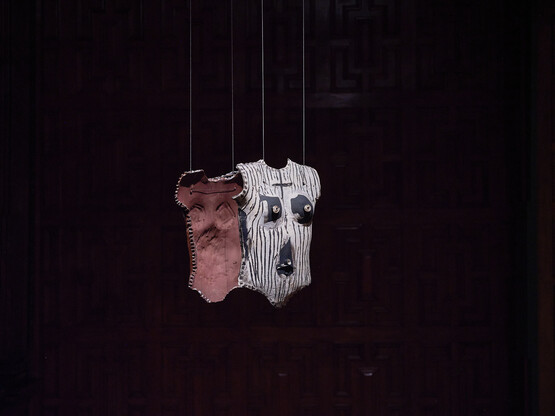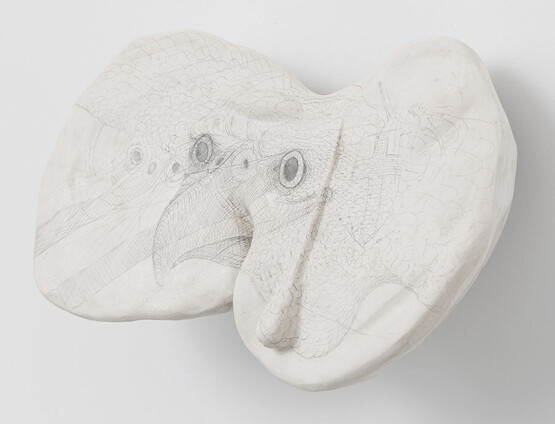

The raucous ceramic and textile installations of Jonathan Baldock (b.1980) FIG.1 are replete with emotion, often drawing on the artist’s personal history, as well as mythic and pagan traditions. Since graduating from the Royal College of Art, London, in 2005, his exhibitions have become increasingly ambitious, encompassing sound, scent and towering sculptures. His last solo show, we are flowers of one garden, at Stephen Friedman, London (20th January–25th February 2023), evolved out of the artist’s close relationship with his mother. Large sculptures resembling flowers FIG.2 reference her passion for gardening, alongside wider themes of nature and life cycles. Such sculptures – some of which include casts of his mother’s face FIG.3 – are at once humorous, touching, terrifying, surreal and yet undeniably lifelike.
Baldock’s solo exhibition Touch Wood at Yorkshire Sculpture Park (YSP; 23rd September 2023–7th July 2024) develops similar themes FIG.4. The double meaning of the title – at once a reference to traditional superstitions and lewd humour – parallels the multi-layered approach of the installation. Here, Baldock’s symbolism originates in the fifteenth-century misericords and carved wooden figures in the nearby Wakefield Cathedral. Misericords are small seats on the undersides of stalls or chairs, designed for monks or canons to rest against for support during long periods of prayer. They are often richly carved with vivid subjects, including mythical beasts, or scenes of everyday life. In this new body of work, Baldock has included casts of his face and body, as well as those of his mother – featuring as part of flower heads or appendages to ceramic vessels FIG.5. This intensely personal approach is woven through with folk motifs, sacred geometric forms and hybrid creatures. Emily Steer interviewed the artist about this new project and his interest in elements from the past that have often survived in secrecy.
Emily Steer (ES): Touch Wood at Yorkshire Sculpture Park brings together multiple threads – from the personal to historical and local research. What was your starting point?
Jonathan Baldock (JB): I’m a fan of gargoyles and so whenever I go to a new place I check if there are relevant architectural sites worth visiting. Wakefield Cathedral doesn’t have gargoyles, but it does have misericords, which are found underneath the seats in the quire – the section where the clergy and choir sit during prayer. They often show weird hybrid beings that are akin to gargoyles. In Wakefield, there’s one carved with an image of a man bending over and baring his bum, which was really funny to me, and became a central part of the exhibition FIG.6. There are a lot of scatological references in misericords; there’s also so much joy in them. The imagery isn’t what we would typically consider to be religious today – they are not necessarily connected to the scriptures – but rather more to do with mythical, pagan or folk beings. For me, they speak to the time and people who made them, who I would say were working people. They are beacons of self-expression, and this became the springboard to reimagine a sacred space for Touch Wood. I wanted to bring these small sculptures that have remained somewhat hidden out into the open and make them monumental.
ES: What sort of imagery do you see recur in the misericords, and how did the makers bring their own creativity to them?
JB: You see the Green Man quite a bit, the origins and significance of which in a Christian context are still unclear FIG.7. For me, from a queer perspective, there’s something important about the misericords existing on the outside and surviving censorship. They survived the Reformation and the conflicts that followed. A leaf was added during the Victorian era to the misericord of the man exposing himself, so it was censored a little, but he’s still there. You can think of it as a silly bit of humour, frivolity and whimsy, but it also speaks to something much more complex. History is not written by working people, so I see these objects as a bridge to the people we don’t know much about.
I grew up around people with religious beliefs, and so I’m very interested in faith but from a distanced position. If you’re gay, you don’t have a place in many religions. But I think about existence and spirituality. Sacred geometry is a recurring motif in this new body of work, which ties into the idea of the never-ending line and interconnectivity of everything. It also relates to nature, which is another major theme in Touch Wood. A lot of these misericords are hybrid versions of animals and nature. There’s a brilliant documentary by Louie Schwartzberg about the mycelium network called Fantastic Fungi (2019) and a book by Merlin Sheldrake titled Entangled Life: How fungi make our worlds, change our minds and shape our futures (2020). These ideas are very ancient, but in a wider, cultural sense, we’re now discovering the extent to which we’re all entangled beings.
ES: There’s been lots of interest in the idea of entanglement recently. In The Milk of Dreams, at the 2022 Venice Biennale, for example, many artists returned to the interconnection between humans, nature and animals. The pandemic and the climate crisis have certainly brought these ideas – which, as you say, aren’t new – into focus as another way of understanding our place in the world.
JB: I grew up around nature and couldn’t wait to get to the big city. I think a lot of queer people have a desire to make that pilgrimage. I’m now in my forties, I don’t have children and people who I care about are dying. There’s a shift in how I’m thinking about why I’m here – it’s a feeling of ‘what’s next?’. In we are flowers of one garden I was aware of my mum not being around for much longer and I wanted to create a show about how important she is to me. But it’s not just a love letter to her and her garden, I was also thinking about my existence, our existence and the purpose of it all. Touch Wood is a continuation of that. I’m finding comfort in learning about the planet and the idea of my body returning to earth and feeding into something else.
ES: In secular cultures, there seems to be a shift in looking for new meanings – ones that connect with ideas of returning to nature rather than heaven or rebirth. We’re also thinking about the future of the planet and the death of the world as we know it.
JB: We’re probably heading for mass extinction, but I think life will continue in a different form. Our existence is so small and insignificant and yet in the West we consider everything in an anthropocentric way. I’m interested in looking at things in a collective manner: organisms make us, we are a universe unto ourselves. I wanted to create a space at YSP that is in parts funny, joyous and meditative. Hopefully it will evoke a feeling similar to what you might experience in a place of worship. A lot of people who don’t follow a religion say that they are still moved by such spaces. I’m attracted to creating that through colour, the handmade and the body.
ES: You also include sound elements in Touch Wood. Your installations have become increasingly sensory – your audiences walk into an environment rather than simply looking at pieces of work.
JB: I love being able to create immersive spaces when I’m given the opportunity. It’s very theatrical. I find a lot of pleasure in the potential for worldbuilding and creating a space to step out of the everyday. The sound has been created by a friend of mine, Luke Barton, who is a musician. He’s incorporated recordings of plants growing and birds at YSP, as well as Morris dancers and my grandad playing the accordion. These samples feed into a soundscape that takes visitors through all four seasons.
ES: It’s interesting that you’ve mentioned theatricality. Your work in Touch Wood inspired by the misericords makes me think of colourful historical storytelling such as Geoffrey Chaucer’s The Canterbury Tales (1387–1400), with its bawdy humour and celebration of working-class narratives.
JB: Exactly. I like imagining what regular people were doing. We’re not that far removed from them. Although we learn about ourselves through the past, history is often viewed through a very narrow, formal perspective. If you were working the land, you’d be surrounded by nature, which can be hard. I can see where this view of it as something powerful and monstrous comes from. I think we’ve lost that.
ES: Can you tell us about the craft processes that you have used in Touch Wood? Are there any techniques that you tried for the first time?
JB: I’ve made works primarily in textile and ceramic, which are very much the core mediums in my practice. All the works are made by hand and the textile pieces have involved months and months of work FIG.8. I would say they are the most ambitious textile pieces I have made in terms of scale – it was a real learning curve. I always talk about the calming and meditative aspect of hand sewing – the meeting of head and hand – but with these I was close to tears on a few occasions. They just wouldn’t play ball. I’m so happy with the outcome of them though. They feel so alive and powerful, which is just what I wanted when I decided to transform the little medieval wooden sculptures into big, imposing, powerful characters. The show also includes basketry FIG.9, metal and glass, although I can’t take credit for all of those elements. They add richness and complexity for the eye so that it never gets bored.
ES: There’s a strong thread of inherited skills running from we are flowers of one garden to Touch Wood. In the former, you thought about the skills you learned from your mum, and in the latter you’re exploring your family tradition of hop farming. How far does your knowledge of this ancestry go?
JB: My mum is very interested in family trees and ancestry. We go to the local churchyards and it’s quite amazing to see the places where my family have been buried for over hundreds of years. There’s no exciting royalty, just people registered to labour on the land; it goes quite far back. The crafts I employ are functional. I’m interested in the handmade but not high-end embroidery or fine beadwork. For textile works FIG.10 I always use blanket stitch, which would have been used by people living in poverty who made things from scraps of material. There’s also a relationship to the body: it’s often the stitch used to sew people up. Even the clay I use, there’s a functionality to it – it’s earthy – and the hessian I use comes from plants. I’m taking something that might be functional or overlooked – in the same way I’m remaking these small wooden misericords – and elevating them in a space where they can be beautiful or monstrous.
ES: Thinking about that relationship with the body, many of the sculptures in we are flowers of one garden and Touch Wood feature the human form trapped in or emerging from another object FIG.11.
JB: Yes, there’s a blur of the body. You could look at them as being trapped or fused. There’s an obvious parallel with our interconnectedness with the earth and nature, but I’m also interested in the connection we have with human-made structures. Throughout history, nature and the body have inspired building design – columns in Classical architecture often have foliate motifs and Greek temples were modelled on the proportions of the human body, for example. Many of the body parts are my own but I don’t want the work to be necessarily ‘about’ me. I’m making votive objects for existence. Part of this is about claiming a space or giving purpose to my existence. It’s also about the ancient idea of metamorphosis – in the human consciousness, we often see ourselves in animals or objects.
ES: we are flowers of one garden was the first time that your mum’s face was cast in the work and she returns in Touch Wood. Why do you directly incorporate her body in your practice?
JB: A lot of my work is a love letter to my mum and nan. When I was growing up, my mum would drop me at my nan’s when she went to work, and my nan would teach me to knit and sew. She wouldn’t do fine needle work; it was very functional. We’d sit in front of the television and chat and I loved it. When I was at art school, the sculpture department always seemed to be a very masculine environment, I was in painting but I still wanted to make three-dimensional, sculptural objects so I relied on the knowledge I already had: the textile skills that I was taught as a child. Later, when I decided to create bigger things, I got my mum involved. She helped me quite a lot with my early shows.
In we are flowers of one garden I wanted to make an ode to her, not only as my mum, but also as a big influence on my work. Her garden is beautiful. She loves flowers and she works hard at it. I thought that was a great springboard for the exhibition. I wanted to capture some permanence, so I cast her body in it. The show was beautiful to create and it was magical to share with her. Making work can allow me to feel more powerful and motivated to make change outside the art world. It can be disempowering to focus on the negatives, which is difficult at the moment as there are so many awful things to be concerned about. How do you fight that?
ES: Growing up in the United Kingdom, I definitely had the impression that we were in a constant state of sociocultural progress, which, in retrospect, is far from the truth. In making Touch Wood I wonder if you have noticed any parallels between contemporary and medieval values towards sexuality, gender and class?
JB: I’ve been thinking about this. It’s hard to project. Many of those perspectives were never documented. A lot of our understanding around sexuality has been moulded over the last two hundred years. Prior to that, on the occasions when homosexuality was evoked in art, it was sometimes linked to humour. But I like to imagine that people are people and it’s always going to have been there. Similarly, before the Reformation there would have been women considered to be healers, who held prominent roles in their community. But this was extinguished with the intensive period of witch-hunting in Europe from the fifteenth century onwards. Previously thought of as intelligent and talented women, they were suddenly rebranded as dangerous witches.
We’re now making a huge amount of progress socially, but there’s always backlash and people resisting. I hone in on bits from the past that have the potential for magic, things that have the potential to empower, that have survived in secrecy.
ES: Your reworking of the misericords would seem to capture that. It’s exciting to think that the person who carved the nude man bending over would have a significant exhibition dedicated to their moment of expression over five hundred years later.
JB: What’s amazing about the misericords is that they are nameless. This is just freedom of expression and pure joy. Using it as an emblem is incredibly powerful. Within this church – which is full of emblems of authority, both religious and political, as we can’t forget the role of patronage in these spaces – there’s this little man baring his bum. We have our systems of value and status, but I want to show humans and even their bodily functions alongside other more ‘serious’ subjects, just like they did in the Middle Ages. We all have the desire to laugh and love; we question our existence in the same way now as we did then.
ES: Although the distinction between secular and religious life exists today in a way that can’t be applied to the time when the misericords were created, they nonetheless seem to manifest as punctures in official narratives. They offer a more human perspective of this period in history. There’s also a strong history of pagan imagery, mythical creatures and goddesses from our land that many don’t connect with growing up. All of this leads the body to be cut off from pleasure and the natural world.
JB: I think many people are seeking that connection again and to challenge historical biases. Victorian attitudes towards sexuality, for example, were a matter of ownership. For me, what’s really fascinating about churches is that they’ve been better preserved than other types of buildings. They are rich material for tracing our histories. In many other areas, such as houses or farms, the past has been erased. The fact that these images have endured in churches of all places blows my mind – it’s a story of survival.



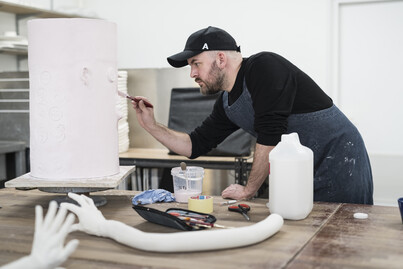
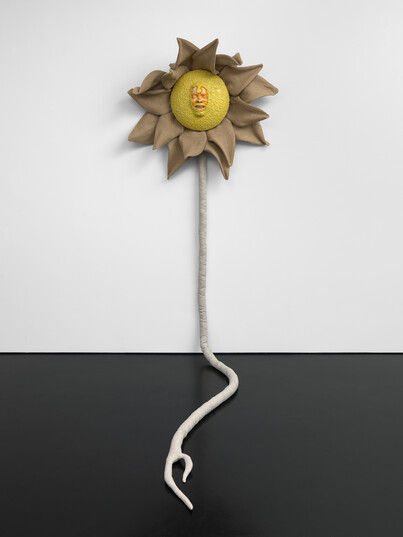


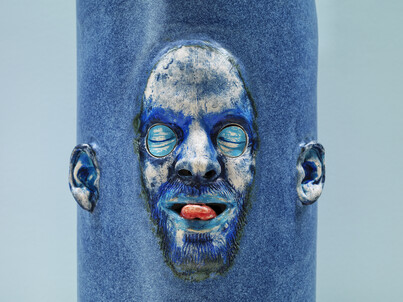
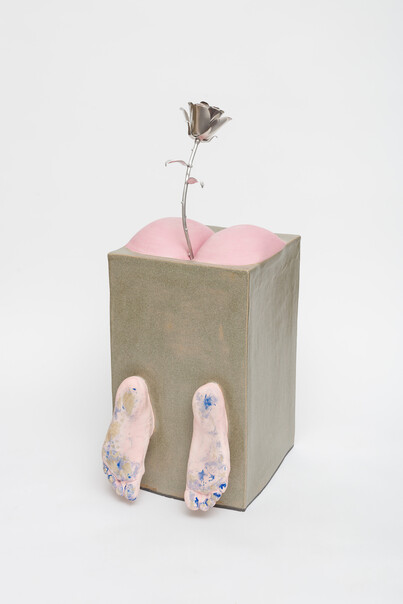

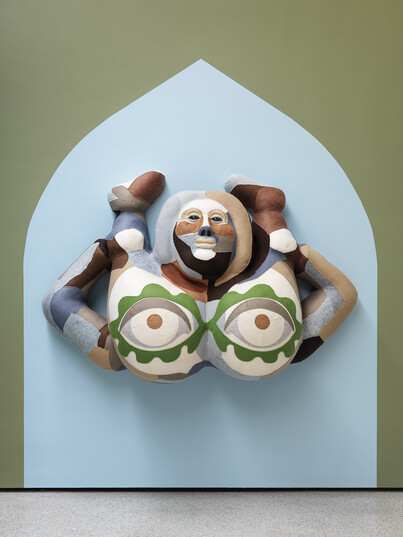
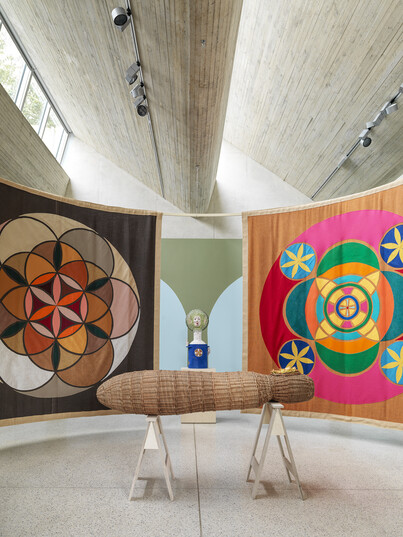
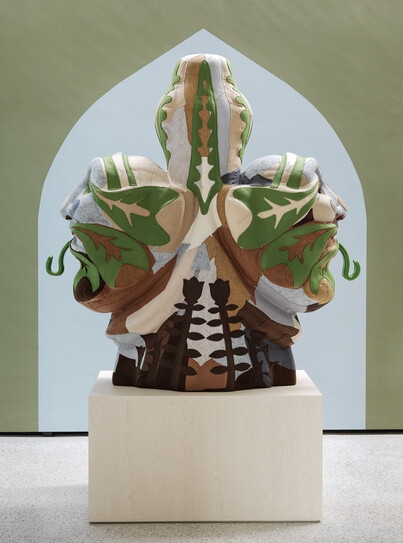
, 2023. courtesy the artist and stephen friedman gallery. photo © mark blower_4.jpg)
